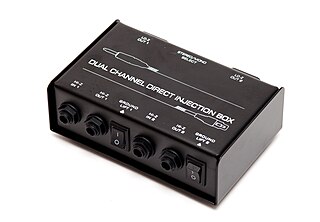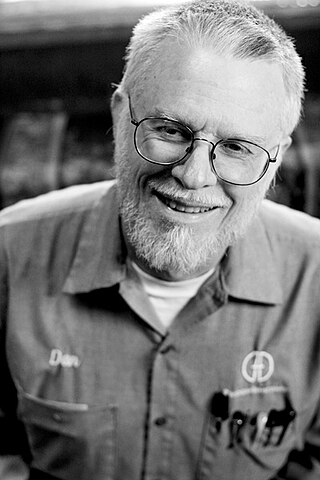
An audio power amplifier amplifies low-power electronic audio signals, such as the signal from a radio receiver or an electric guitar pickup, to a level that is high enough for driving loudspeakers or headphones. Audio power amplifiers are found in all manner of sound systems including sound reinforcement, public address, home audio systems and musical instrument amplifiers like guitar amplifiers. It is the final electronic stage in a typical audio playback chain before the signal is sent to the loudspeakers.

A mixing console or mixing desk is an electronic device for mixing audio signals, used in sound recording and reproduction and sound reinforcement systems. Inputs to the console include microphones, signals from electric or electronic instruments, or recorded sounds. Mixers may control analog or digital signals. The modified signals are summed to produce the combined output signals, which can then be broadcast, amplified through a sound reinforcement system or recorded.

A DI unit is an electronic device typically used in recording studios and in sound reinforcement systems to connect a high output impedance unbalanced output signal to a low-impedance, microphone level, balanced input, usually via an XLR connector and XLR cable. DIs are frequently used to connect an electric guitar or electric bass to a mixing console's microphone input jack. The DI performs level matching, balancing, and either active buffering or passive impedance matching/impedance bridging. DI units are typically metal boxes with input and output jacks and, for more expensive units, “ground lift” and attenuator switches.

A stage box is an interface device used in sound reinforcement and recording studios to connect equipment to a mixing console. It provides a central location to connect microphones, instruments, and speakers to a multicore cable (snake), which allows the sound desk to be further from the stage and simplifies setup.

A sound reinforcement system is the combination of microphones, signal processors, amplifiers, and loudspeakers in enclosures all controlled by a mixing console that makes live or pre-recorded sounds louder and may also distribute those sounds to a larger or more distant audience. In many situations, a sound reinforcement system is also used to enhance or alter the sound of the sources on the stage, typically by using electronic effects, such as reverb, as opposed to simply amplifying the sources unaltered.
Solid State Logic (SSL) is a British company based in Begbroke, Oxfordshire, England that designs and markets audio mixing consoles, signal processors, and other audio technologies for the post-production, video production, broadcast, sound reinforcement and music recording industries. SSL employs over 160 people worldwide and has regional offices in Los Angeles, Milan, New York City, Paris, and Tokyo, with additional support provided by an international network of distributors. Solid State Logic is part of the Audiotonix Group.

An aux-send is an electronic signal-routing output used on multi-channel sound mixing consoles used in recording and broadcasting settings and on PA system amplifier-mixers used in music concerts. The signal from the auxiliary send is often routed through outboard audio processing effects units and then returned to the mixer using an auxiliary return input jack, thus creating an effects loop. This allows effects to be added to an audio source or channel within the mixing console. Another common use of the aux send mix is to create monitor mixes for the onstage performers' monitor speakers or in-ear monitors. The aux send's monitor mix is usually different from the front of house mix the audience is hearing.

A DJ mixer is a type of audio mixing console used by disc jockeys (DJs) to control and manipulate multiple audio signals. Some DJs use the mixer to make seamless transitions from one song to another when they are playing records at a dance club. Hip hop DJs and turntablists use the DJ mixer to play record players like a musical instrument and create new sounds. DJs in the disco, house music, electronic dance music and other dance-oriented genres use the mixer to make smooth transitions between different sound recordings as they are playing. The sources are typically record turntables, compact cassettes, CDJs, or DJ software on a laptop. DJ mixers allow the DJ to use headphones to preview the next song before playing it to the audience. Most low- to mid-priced DJ mixers can only accommodate two turntables or CD players, but some mixers can accommodate up to four turntables or CD players. DJs and turntablists in hip hop music and nu metal use DJ mixers to create beats, loops and so-called scratching sound effects.
In audio processing and sound reinforcement, an insert is an access point built into the mixing console, allowing the audio engineer to add external line level devices into the signal flow between the microphone preamplifier and the mix bus.

The Korg MS2000 is a virtual analog synthesizer produced by the Japanese electronic musical instrument manufacturer Korg.

In professional audio, a digital mixing console (DMC) is a type of mixing console used to combine, route, and change the dynamics, equalization and other properties of multiple audio input signals, using digital signal processing rather than analog circuitry. The digital audio samples, which is the internal representation of the analog inputs, are summed to what is known as a master channel to produce a combined output. A professional digital mixing console is a dedicated desk or control surface produced exclusively for the task and is typically more robust in terms of user control, processing power and quality of audio effects. However, a computer can also perform the same function since it can mimic its interface, input and output.
Soundcraft is a British designer and importer of mixing consoles and other professional audio equipment. It is a subsidiary of Harman International Industries, which is owned by South Korean company Samsung Electronics. It was founded by sound engineer Phil Dudderidge and electronics designer Graham Blyth in 1973.

Live sound mixing is the blending of multiple sound sources by an audio engineer using a mixing console or software. Sounds that are mixed include those from instruments and voices which are picked up by microphones and pre-recorded material, such as songs on CD or a digital audio player. Individual sources are typically equalised to adjust the bass and treble response and routed to effect processors to ultimately be amplified and reproduced via a loudspeaker system. The live sound engineer listens and balances the various audio sources in a way that best suits the needs of the event.
VENUE is a brand of live sound digital mixing consoles introduced by Digidesign in February 2005. The family now includes 5 different consoles and a number of ways they can be configured. They can all be connected to Pro Tools, the audio editing software also created by Avid/Digidesign, to provide recording and 'Virtual Soundcheck' facilities. One of the system's key marketing points is its use of the same AAX DSP/TDM plugins as Pro Tools, an industry standard digital audio workstation (DAW). This is designed to enable the sounds recorded by the artist in the studio to be easily recreated on stage, and to allow for greater flexibility in signal processing without heavy and mechanical-shock-sensitive racks of external processors. There is also a PC-based offline editor for creation and editing of show files, although there is no audio processing in the editor.
A Virtual Mixer is a software application that runs on a computer or other digital audio system. Providing the same functionality of a digital or analog mixing console, a virtual mixer takes the audio outputs of many separate tracks or live sources and combines them into a pair of stereo outputs or other routed subgroups for auxiliary outputs.
Yamaha Pro Audio, Inc. is a division of the Yamaha Corporation that offers a complete line of beginner professional audio products for the live sound and sound reinforcement markets. It has a long history of introducing significant products for the professional audio market such as the PM-1000 modular mixing console, the REV1 and SPX90 digital signal processors, the NS-10 studio monitors, and the 01v, 02R, 03D, PM1D, PM5D, QL5, M7CL, CL5, and PM10/7 Rivage digital mixing consoles.

An automixer, or automatic microphone mixer, is a live sound mixing device that automatically reduces the strength of a microphone's audio signal when it is not being used.

In sound recording and reproduction, audio mixing is the process of optimizing and combining multitrack recordings into a final mono, stereo or surround sound product. In the process of combining the separate tracks, their relative levels are adjusted and balanced and various processes such as equalization and compression are commonly applied to individual tracks, groups of tracks, and the overall mix. In stereo and surround sound mixing, the placement of the tracks within the stereo field are adjusted and balanced. Audio mixing techniques and approaches vary widely and have a significant influence on the final product.

Dan Dugan is an American audio engineer, inventor, and nature sounds recordist. He was the first person in regional theatre to be called a sound designer, and he developed the first effective automatic microphone mixer: the automixer. Dugan's sound design work was acknowledged in 2003 with a Distinguished Career Award by the United States Institute for Theatre Technology, and in 2020 with an Emmy Award for technology relevant to remote working. In 2021 he was awarded Fellowship in the Audio Engineering Society.

A matrix mixer is an audio electronics device that routes multiple input audio signals to multiple outputs. It usually employs level controls such as potentiometers to determine how much of each input is going to each output, and it can incorporate simple on/off assignment buttons. The number of individual controls is at least the number of inputs multiplied by the number of outputs.

















